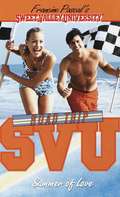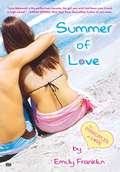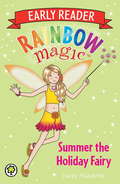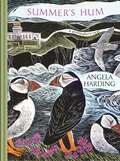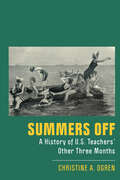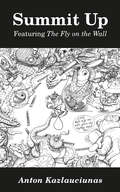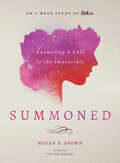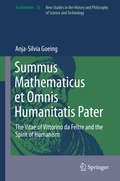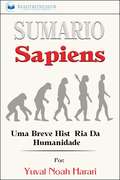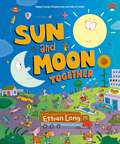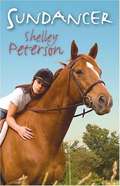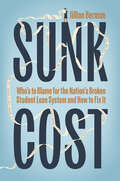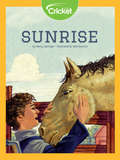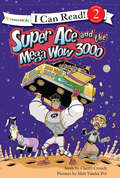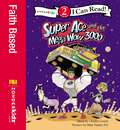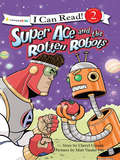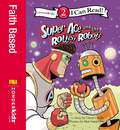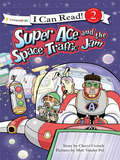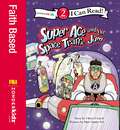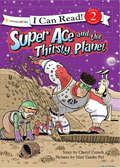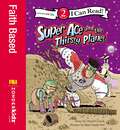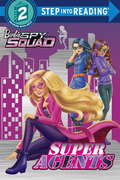- Table View
- List View
Summer of Love (Sweet Valley University #50)
by Francine Pascal Laurie JohnThe end of the road... A $5,000 scholarship is just a mission away, but Elizabeth Wakefield would rather win Sam Burgess's love. Impossible--since Sam's girlfriend is waiting for him at the finish line. Well, Elizabeth hasn't come this far for nothing. She's going to show Sam how strong she really is... even if it kills her. The final straw? Jessica Wakefield has had it! Her team does nothing but argue, she hasn't hooked up with anyone, and her final mission involves facing one of her biggest fears. Will she abandon her team at the last minute? Tom Watts and Todd Wilkins--best buddies? Absolutely! Angered by Sam's treatment of Elizabeth, they're ready to fight for her--unless they wind up fighting over her instead!
Summer of Love: The Principles of Love
by Emily FranklinAfter a rough spring semester at Hadley Hall, Love Bukowski is ready for some sun on Martha's Vineyard. Running her Aunt Mable's cafe might not sound glamorous, but when she's working with her best friend, Arabella, anything can be fun. Plus, Mable's set up a treasure map of clues for her to find--each one bringing Love closer to the truth about her family history. But now that those pieces of her past are finally fitting together, Love's future isn't clear. College and senior year are ahead, but the boys of summer are more appealing than ever. Surprises, sun, summer love--no matter what happens, the next three months will be ones to write home about.
Summer the Holiday Fairy (Rainbow Magic Early Reader #5)
by Daisy MeadowsThese cheerful and inviting Early Readers bring the blast of colour that Rainbow Magic's youngest fans have been waiting for!Rachel and Kirsty are on a trip to Rainspell Island. But Jack Frost has taken the three magical shells that make all holidays full of fun and sun! Can the girls help Summer the Holiday Fairy get them back before the Ice Lord ruins all holidays?'These stories are magic; they turn children into readers!' ReadingZone.comIf you like Rainbow Magic, check out Daisy Meadows' other series: Magic Animal Friends and Unicorn Magic!
Summer's Hum: part of a beautiful new series from beloved illustrator and print-maker Angela Harding
by Angela Harding'The wildflower bank outside my window hums and buzzes. At midday, the summer sun spreads the perfume of roses and honeysuckle to every corner.'Summer's Hum is the second book in a stunning seasonal quartet from beloved printmaker and illustrator Angela Harding. Each title in this pocket-sized series takes readers on a journey through the seasons, reflecting Angela's observations as the nature around her transforms and evolves over the course of a year. Taking in landscapes across the UK including views from her home studio in Rutland, to the Scottish wilderness, via the low-lying marshlands of Suffolk and the windswept hills of Yorkshire, the beautiful illustrations and evocative imagery of the prose make this the perfect book for nature lovers and art lovers everywhere.Featuring over thirty of Angela Harding's favourite prints alongside observations taken from her books A Year Unfolding, Wild Light and Still Waters & Wild Waves, each short, small book in this seasonal collection is a beautiful new way to enjoy Angela's work and celebrate nature and wildlife across the UK at all times of year.Collect all four titles: Spring Unfurled, Summer's Hum, Falling into Autumn, Winter's Song.
Summer's Hum: part of a beautiful new series from beloved illustrator and print-maker Angela Harding
by Angela Harding'The wildflower bank outside my window hums and buzzes. At midday, the summer sun spreads the perfume of roses and honeysuckle to every corner.'Summer's Hum is the second book in a stunning seasonal quartet from beloved printmaker and illustrator Angela Harding. Each title in this pocket-sized series takes readers on a journey through the seasons, reflecting Angela's observations as the nature around her transforms and evolves over the course of a year. Taking in landscapes across the UK including views from her home studio in Rutland, to the Scottish wilderness, via the low-lying marshlands of Suffolk and the windswept hills of Yorkshire, the beautiful illustrations and evocative imagery of the prose make this the perfect book for nature lovers and art lovers everywhere.Featuring over thirty of Angela Harding's favourite prints alongside observations taken from her books A Year Unfolding, Wild Light and Still Waters & Wild Waves, each short, small book in this seasonal collection is a beautiful new way to enjoy Angela's work and celebrate nature and wildlife across the UK at all times of year.Collect all four titles: Spring Unfurled, Summer's Hum, Falling into Autumn, Winter's Song.
Summerhill: A Radical Approach to Child Rearing
by A. S. NeillThe world's greatest experiment in bestowing unstinted love and approval on children, by applying the principles of freedom and non-repression.
Summers Off?: A History of U.S. Teachers' Other Three Months (New Directions in the History of Education)
by Christine A. OgrenSince the nine-month school year became common in the United States during the 1880s, schoolteachers have never really had summers off. Administrators instructed them to rest, as well as to study and travel, in the interest of creating a compliant workforce. Teachers, however, adapted administrators’ directives to pursue their own version of professionalization and to ensure their financial well-being. Summers Off explores teachers’ summer experiences between the 1880s and 1930s in institutes and association meetings; sessions at teachers colleges, Black colleges, and prestigious universities; work for wages or their family; tourism in the U.S. and Europe; and activities intended to be restful. This heretofore untold history reveals how teachers utilized the geographical and psychological distance from the classroom that summer provided, to enhance not only their teaching skills but also their professional and intellectual independence, their membership in the middle class, and, in the cases of women and Black teachers, their defiance of gender and race hierarchies.
Summit Up
by Anton KazlauciunasThe more we look, the more we see. The more we see, the more we understand. With our eyes we see, we ruminate, speculate, compare, compose, even cogitate a little, animadvert perhaps, create balance, empathy, order out of chaos, understanding rises from conflict, beauty out of the undefined, trust replaces prejudice and suspicion, light emerges from the darkness, love out of hate, peace from war. We create hopes of dreams, belief out of impossibility, reality materializes from imagination. And so artists draw. Please read the pictures and think for yourselves.
Summoned: Answering a Call to the Impossible: An 8-Week Study of Esther
by Megan B. BrownEncounter the fullness of God&’s grace, the power of His promises, and the beauty of His faithfulness—all through the life of one woman: Esther.In a time when the world around her seemed to crumble, a young Hebrew girl found herself in a unique position to help save her people—and to encounter the greatness of our ever-faithful God. In Summoned, you&’ll enter the story of Esther—her calling, pain, and role in God&’s ultimate plan for salvation—and see how God is always working in the lives of His people, even when He seems distant. Through this 8-week, interactive study, you&’ll develop a deeper appreciation for God&’s Word and begin to see that stepping out in faith for His glory is often the first step to encountering His redeeming love.
Summoned: Answering a Call to the Impossible: An 8-Week Study of Esther
by Megan B. BrownEncounter the fullness of God&’s grace, the power of His promises, and the beauty of His faithfulness—all through the life of one woman: Esther.In a time when the world around her seemed to crumble, a young Hebrew girl found herself in a unique position to help save her people—and to encounter the greatness of our ever-faithful God. In Summoned, you&’ll enter the story of Esther—her calling, pain, and role in God&’s ultimate plan for salvation—and see how God is always working in the lives of His people, even when He seems distant. Through this 8-week, interactive study, you&’ll develop a deeper appreciation for God&’s Word and begin to see that stepping out in faith for His glory is often the first step to encountering His redeeming love.
Summus Mathematicus et Omnis Humanitatis Pater
by Anja-Silvia GoeingThis book revises the picture of the teacher and educator of princes, Vittorino Rambaldoni da Feltre (c. 1378, Feltre -- 1446, Mantua), taking a completely new approach to show his work and life from the individual perspectives created by his students and contemporaries. From 1423 to 1446, Vittorino da Feltre was in charge of a school in Mantua, where his students included not only the offspring of Italy's princes, but also the first generation of authors dealing with books in print. Among his students were historians like Bartolomeo Sacchi (named Platina), who wrote an extensive history of the popes, and mathematicians like Jacopo Cassiano (Cremonensis), who translated the work of Archimedes from Greek into Latin. Vittorino is still regarded as the educationalist of Italian Renaissance humanism per sé. This work not only contributes to the study of the history of Italian humanist institutions, it also uses available sources to demonstrate the development of a new attitude to education in Italy.
Sumário de Sapiens: Uma Breve História da Humanidade
by Readtrepreneur PublishingSumário do Livro Sapiens: Uma Breve História da Humanidade de Yuval Noah Harari Como conseguimos chegar tão longe? Nós, os Homo sapiens, dominamos o mundo porque somos o único animal que acredita no poder da imaginação. Escrito pelo Dr. Yuval Noah Harari, Sapiens é uma obra-prima verdadeiramente única. Enquanto outros livros têm como tópicos principais somente a parte histórica ou biológica dos seres humanos, “Sapiens” destaca as três grandes revoluções da história da humanidade: a Revolução Cognitiva, a Revolução Agrícola e a Revolução Científica. “Não existe nenhuma coisa que seja verdade. Tudo é verdade” – Yuval Noah Harari O Dr. Harari agora nos aconselha a pensar no futuro porque as coisas estão mudando. Está provado que nós, seres humanos, não apenas revolucionamos o mundo, mas também as nossas vidas. Nós nos desenvolvemos, nós nos aperfeiçoamos e nós nos transformamos. E esta transformação vai continuar acontecendo. Aonde ela vai nos levar? Aonde vamos chegar? Em que estamos nos transformando? (Observação: Este sumário foi integralmente escrito e publicado pela readtrepreneur.com. Ele não tem nenhuma ligação com o livro original do autor) P.S. Enriqueça o seu cérebro de sabedoria e conhecimento com este livro. Descubra que você é muito mais do que realmente pensa que é. Você vai gostar muito deste livro. Afinal, você é um ser humano. Chega de pensar! É hora de agir! Clique no botão “Buy now with 1-Click” e receba uma cópia imediatamente! Por que escolher a Readtrepreneur? Resumos de alta qualidade Garantia de incríveis conhecimentos Atualizações fantásticas Clareza e precisão Isenção de responsabilidade: Este livro destina-se a ser um excelente guia do livro original ou apenas uma síntese do livro original. Se você procura pelo livro original, clique no seguinte link: http://amzn.to/2qxORbB
Sun and Moon Together: Happy County Book 2 (Happy County #2)
by Ethan LongSun and Moon Together is a vibrant, graphic picture book compendium for preschoolers set in a Richard Scarry-inspired environment by Geisel Award-winning creator Ethan Long.Welcome to another busy day in Happy County! The Sun is out and shining down on lots of friends. Grammy Tammy from Miami is doing grimey, slimey laundry. Sssonny Sssnakerton wants to grow sssunflowers. And when the Sun says goodbye for the day, the Moon pops up for a new set of adventures. Now Molly and her mom can make moon shadows and howl night noises. This 48-page full-color primer is chock-full of charming characters and basic scientific concepts connected to the sun and the moon presented in simple, accessible terms for the young audience, touching on: the water cycle, phases of the moon, the solar system, and plenty of clever scenarios to keep little ones engaged. Happy County#1 Hello, World!#2 Sun and Moon TogetherChristy Ottaviano Books
Sundancer
by Shelley PetersonFrom the outside, 13-year-old Alberta-- aka Bird-- looks like a typical teenager. She spends her days attending school, riding horses and helping out on the farm where she lives with her Aunt Hannah. But Bird is anything but typical.
Sunk Cost: Who’s to Blame for the Nation’s Broken Student Loan System and How to Fix It
by Jillian BermanExposes the forgotten origins of the student loan system, how politicians have attempted to fix it, and the life-altering damage borrowers face. Student-loan horror stories are a dime a dozen. But students today are faced with a seemingly insurmountable paradox: Research consistently shows that the clearest viable option to financial stability is a college degree. But if and when Americans decide to pursue diplomas, student loan payments quickly follow, and even after securing full-time employment, many borrowers struggle to make ends meet for years. In Sunk Cost, journalist Jillian Berman explores how the nation’s student loan program went from a well-intentioned initiative aimed at helping low- and middle-income students afford college to one that traps borrowers in long-term debt. Berman interviewed dozens of borrowers and policymakers and dug into the archives to unearth the true causes of the student loan problem. A couple of generations ago, policy makers generously subsidized Americans’ college educations because they knew it would be advantageous for the entire country: a more educated population meant better quality of life for all. But today, higher education is viewed as an individual goal, so students and their families are expected to be on the hook for it themselves. Berman explains how this enormous shift happened, which industries benefit from it, and what it means for college-going Americans today. She shares real-life stories of college graduates who are being crushed under some of the harshest consequences of the student loan system. These borrowers pursued higher education in hopes of a better life and yet some have been trapped in debt for decades, making it difficult to put food on the table, much less imagine a life beyond debt. By connecting personal accounts to the policy history of student loans, Berman makes clear that if American society continues to push students toward higher education, but fails to truly subsidize it, the financial strain will become unbearable for all but the most privileged. The current system is broken, but Berman proposes that significant changes are possible, and will require political will from state lawmakers and Congress, along with a philosophical shift, to tackle one of the largest consumer finance challenges of our time.
Sunrise
by Nancy SpringerMike doesn’t want to learn to ride horses! He is content trying to show everyone that not all kids in wheelchairs are nice, but his physical therapist wants him to try horseback riding to help strengthen his legs. Will Liverwurst the horse help him develop a different attitude towards his disability?
Super Ace and the Mega Wow 3000 (I Can Read! #Level 2)
by Cheryl CrouchSpace hero Super Ace is called to planet Floop because the Mega Wow 3000, a spaceship loaded with food for hungry children, will not go. Super Ace tries to use his super powers, (strength and good looks) to fix the ship. With his big arms, he bends and lifts and moves the Mega Wow. Pieces of the Mega Wow snap and pop, but the ship still will not work. When the ship’s owner turns to Sidekick Ned, Super Ace laughs. But Ned uses his God-given wisdom to find the key that turns on the ship. Now the hungry children will get their food! This level-two I Can Read book uses engaging characters and a simple plot to build children’s confidence as they discover the joy of reading independently.
Super Ace and the Mega Wow 3000: Level 2 (I Can Read! / Superhero Series)
by Cheryl Crouch Matt Vander PolA Lesson in Letting Your Light Shine.Hungry children are waiting for food packed in the Mega Wow 3000. But the spaceship will not go. Can Super Ace use his superpowers to fix the ship? Could Ned help?This is a Level Two I Can Read! book, which means it&’s perfect for children learning to sound out words and sentences. It aligns with guided reading level I and will be of interest to children Pre-K to 3rd grade
Super Ace and the Rotten Robots (I Can Read! #Level 2)
by Cheryl CrouchSpace hero Super Ace is called to planet Roop because the planet’s robots are making messes, being mean, and ruining everything. The planet is in chaos! Super Ace tries to use his super powers (strength and good looks) to make the robots obey him, but no matter what he tries, the robots are still bad. The planet leader turns to sidekick Ned, and Super Ace laughs. But Ned uses his God-given wisdom to discover that the main switch at Robot Control has been bumped. The lever that should point to Good now points to Bad. That’s why the robots are bad. They can’t choose how to act, like people can. Ned moves the lever to Good, and the robots begin to clean up the mess and help people again. This level-two I Can Read book uses engaging characters and a simple plot to build children’s confidence as they discover the joy of reading independently.
Super Ace and the Rotten Robots: Level 2 (I Can Read! / Superhero Series)
by Cheryl Crouch Matt Vander PolSpace hero Super Ace is called to planet Roop because the planet&’s robots are making messes, being mean, and ruining everything. The planet is in chaos! Super Ace tries to use his super powers (strength and good looks) to make the robots obey him, but no matter what he tries, the robots are still bad. The planet leader turns to sidekick Ned, and Super Ace laughs. But Ned uses his God-given wisdom to discover that the main switch at Robot Control has been bumped. The lever that should point to Good now points to Bad. That&’s why the robots are bad. They can&’t choose how to act, like people can. Ned moves the lever to Good, and the robots begin to clean up the mess and help people again. This level-two I Can Read book uses engaging characters and a simple plot to build children&’s confidence as they discover the joy of reading independently.
Super Ace and the Space Traffic Jam (I Can Read! #Level 2)
by Cheryl CrouchSpace hero Super Ace is called to planet Joop to fix a galactic space traffic jam. He and Sidekick Ned can’t even get to the planet because there are wrecks everywhere. Super Ace tries to use his super powers (strength and good looks) to clear the traffic and get everyone moving again, but his attempts only make the situation worse. Ned uses his God-given wisdom to solve the traffic problem. The galactic space stop light is flashing every color of the rainbow, so space ship drivers don’t know if they should go, slow down, or stop. He knows people have to follow the rules to be safe. Ned fixes the light and the drivers stop crashing. This level-two I Can Read book uses engaging characters and a simple plot to build children’s confidence as they discover the joy of reading independently.
Super Ace and the Space Traffic Jam: Level 2 (I Can Read! / Superhero Series)
by Cheryl Crouch Matt Vander PolA Lesson in Following Rules.Super Ace is needed on planet Joop! But he&’s stuck in an outer space traffic jam, where superpowers don&’t help. Sidekick Ned isn&’t strong or good-looking—but he might have the answer.This is a Level Two I Can Read! book, which means it&’s perfect for children learning to sound out words and sentences. It aligns with guided reading level I and will be of interest to children Pre-K to 3rd grade.
Super Ace and the Thirsty Planet (I Can Read! #Level 2)
by Cheryl CrouchSpace hero Super Ace is called to planet Woop because the main river has dried up. No one can drink or bathe, and they are cranky and smelly. Super Ace tries to use his super powers (strength and good looks) to find a way for the people to smell better and not be so thirsty. Nothing he tries works. The planet leader turns to Sidekick Ned, but Super Swish laughs. Ned uses his God-given wisdom to discover that a huge boulder has fallen into the river and blocked the water. Super Ace feels bad until Ned asks him to help by moving the large rock. Super Ace and Sidekick Ned are glad they have worked together. This level-two I Can Read book uses engaging characters and a simple plot to build children’s confidence as they discover the joy of reading independently.
Super Ace and the Thirsty Planet: Level 2 (I Can Read! / Superhero Series)
by Matt Vander PolA Lesson in Cooperation.Planet Woop is out of water. Everyone is thirsty and smelly. When superpowers don&’t work, Ned has an idea. But he can&’t do it alone. Will Super Ace help?This is a Level Two I Can Read! book, which means it&’s perfect for children learning to sound out words and sentences. It aligns with guided reading level I and will be of interest to children Pre-K to 3rd grade.
Super Agents (Barbie Spy Squad)
by Melissa LagonegroChildren ages 4 to 6 will love this deluxe Step 2 Step into Reading leveled reader based on Barbie's latest movie, releasing in spring 2016. Step 2 Readers use basic vocabulary and short sentences to tell simple stories. For children who recognize familiar words and can sound out new words with help.
